Explore Kamakura - Japan Travel, Asia
Kamakura, a coastal city just south of Tokyo, is a treasure trove of history and culture. Known for its ancient temples, stunning beaches, and rich heritage, Kamakura offers a serene escape from the bustling capital. Let’s explore Kamakura through its storied past, its vibrant local culture, and the must-see attractions that make it a top destination for travelers. Whether you're a history buff, a foodie, or simply in search of a picturesque getaway, Kamakura has something for everyone.
Seeking a tailored Japan adventure? Explore our premium Japan tour offerings here.
Population: Approximately 173,000 in 2020.
Economy: The dominant industry ruling Kamakura’s economy is tourism, with visitors drawn to its historical sites, cultural heritage, and natural beauty.
Landmarks: Famous for the Great Buddha of Kamakura (or Kotoku-in), Tsurugaoka Hachimangu Shrine, and Kencho-ji Temple.
Japan
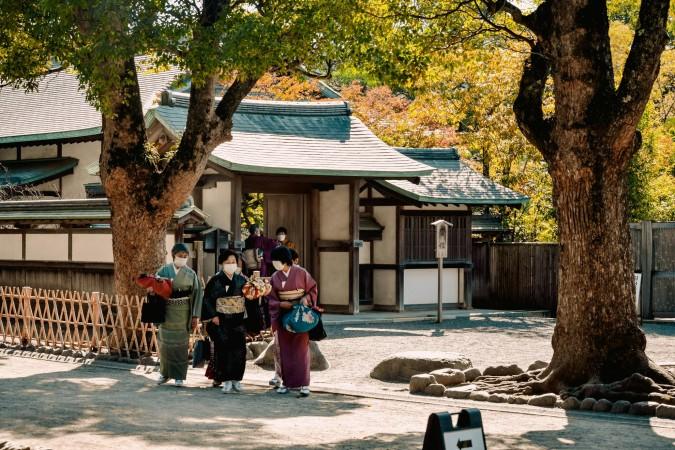
Overview of Kamakura
History & Cultural Influence
Kamakura's history dates back to the 12th century when it served as the political center of Japan during the Kamakura Shogunate. This historical period made a lasting impression on the city, as seen by the abundance of temples, shrines, and samurai customs. One of the most significant periods in Japanese history, the Kamakura period, saw the rise of Zen Buddhism, which continues to influence the city's cultural landscape today. A visit to Kamakura is incomplete without exploring its historical sites. The Great Buddha of Kamakura (Kotoku-in) is an iconic symbol. This bronze statue, dating back to the 13th century, exemplifies the city's rich artistic and cultural heritage.
Interaction with The Locals
Kamakura, with a population of around 173,000 residents, is a charming blend of tradition and modernity. The citizens of Kamakura are known for their warm hospitality and pride in their rich cultural heritage. Many locals are deeply connected to the city's historical roots, often participating in traditional festivals and maintaining ancient customs. Visitors are drawn to this tight-knit town because of its harmonious fusion of the past and present, which is a result of its appreciation for both the preservation of its historical landmarks and the natural beauty of its seaside surroundings.
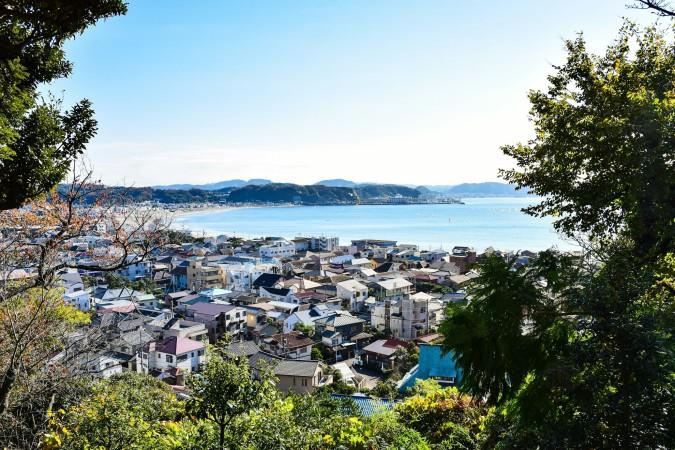
Kamakura-Shi, the coastal city - © AXP Photography
Top Attractions in Kamakura
Kamakura's blend of historical sites, cultural experiences, and natural beauty makes it a captivating destination for travelers. By exploring these top attractions, you'll gain a deeper appreciation for the city's rich heritage and vibrant present.
- Great Buddha of Kamakura (Kotoku-in): The Great Buddha, or Kamakura Daibutsu, is one of Japan’s most iconic landmarks. This colossal bronze statue stands at approximately 13.35 meters (43.8 feet) and represents Amida Buddha. Located at Kōtoku-in Temple, the statue dates back to 1252 and was originally housed in a grand hall that was destroyed by a tsunami in 1495.
- Tsurugaoka Hachimangu Shrine: Kamakura’s most significant Shinto shrine, dedicated to Hachiman, the deity of war and the protector of the Minamoto clan. Established in 1063, the shrine is known for its beautiful red torii gates, expansive grounds, and picturesque pond. The approach to the shrine, known as Wakamiya Ōji, is lined with cherry trees that bloom spectacularly in spring.
- Hasedera Temple: Also known as Hase Kannon, the temple is renowned for its stunning gardens and impressive wooden statue of Kannon, the Buddhist goddess of mercy. Founded in the 8th century, the temple offers breathtaking views of Kamakura from its hillside location. The temple grounds feature beautiful hydrangea gardens, especially spectacular during the rainy season
- Kencho-ji Temple: The oldest Zen temple in Kamakura established in 1253. It is an important spiritual site and part of the Rinzai Zen school. The temple complex includes a grand entrance gate, beautiful Zen gardens, and various halls, including the Main Hall (Hatto) and the Dharma Hall (Butsuden). The temple’s tranquil atmosphere makes it a serene spot for meditation and reflection.
- Hokoku-ji Temple (Bamboo Temple): Famous for its enchanting bamboo grove, the temple, founded in 1334, features a beautiful Zen garden surrounded by dense bamboo. The bamboo forest provides a serene and calming environment, perfect for a peaceful stroll. The temple also offers matcha tea and traditional sweets in its tea house.
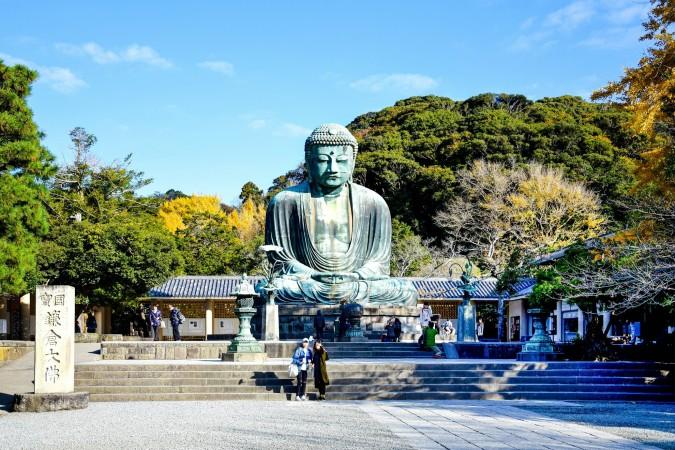
Great Buddha of Kamakura (Kamakura Daibutsu) - © AXP Photography
Must-Try Dishes in Kamakura
Kamakura’s coastal location means fresh seafood is always on the menu. From sashimi to grilled fish, the variety of seafood dishes available is impressive. Don’t miss trying these local specialties!
- Shirasu (Whitebait): Shirasu is a local delicacy in Kamakura, typically served raw, boiled, or dried. This tiny fish is often enjoyed over rice, in sushi, or as a topping for various dishes. Fresh and flavorful, shirasu is a must-try for seafood lovers visiting the city.
- Kamakura Chazuke: Chazuke is a simple yet comforting dish made by pouring green tea over rice, often topped with pickles, seaweed, and fish. In Kamakura, chazuke is typically made with shirasu, giving it a unique local twist. It's a light and flavorful meal that reflects the city’s culinary traditions.
- Kaiseki Ryori: Kaiseki ryori is a traditional multi-course Japanese meal that emphasizes seasonal ingredients and artistic presentation to delight both the palate and the eyes.
- Sakana no Nanban-zuke: This recipe calls for marinated fish that is often deep-fried before being drenched in a zesty sauce made with veggies and vinegar. It’s a refreshing and flavorful dish that highlights the freshness of Kamakura’s seafood.
- Kamakura Cider: While not a dish, Kamakura cider is a refreshing local beverage made from apples grown in the region. It pairs well with many local dishes and provides a crisp, sweet contrast to the savory flavors of Kamakura's cuisine.
Looking for more adventures? Dive into Tokushima, another famous destination in Japan, with our article here.
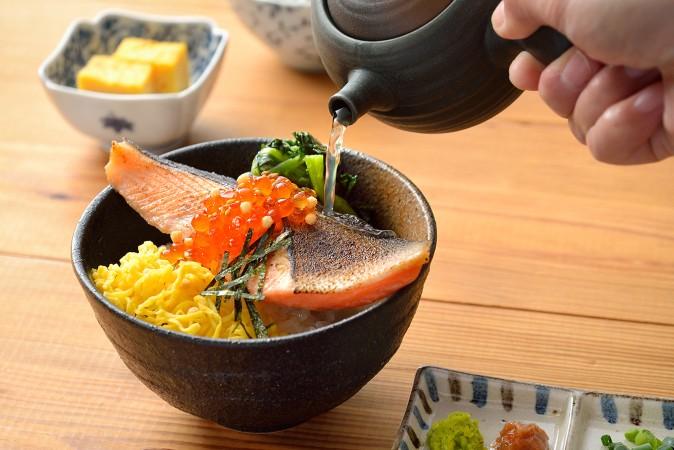
Kamakura Chazuke - © HYAKKEI
Festivals & Local Celebrations
Kamakura Matsuri
Kamakura Matsuri, held every April, is a vibrant festival celebrating the city’s rich history and cultural heritage. The festival spans an entire week and includes various traditional performances, such as taiko drumming, lion dances, and Noh theater. One of the highlights is the grand parade, featuring locals dressed in historical samurai costumes marching through the streets of Kamakura. The procession often includes portable shrines (mikoshi), which are carried through the city in a lively display of devotion and community spirit. The festival also offers food stalls, games, and activities, creating a festive atmosphere that attracts both locals and tourists.
Hasedera Hydrangea Festival
Every June, Hase-dera Temple hosts the Hydrangea Festival, celebrating the stunning beauty of hydrangeas in full bloom. The temple grounds are home to over 2,500 hydrangea plants, which create a breathtaking sea of blue, pink, and purple flowers. Visitors can stroll along the temple’s paths, taking in the picturesque scenery and enjoying the fragrant blossoms. The festival is an excellent opportunity to experience the tranquility and natural beauty of Kamakura, with the added bonus of exploring Hase-dera Temple’s historic buildings and serene gardens. Special events and activities, such as tea ceremonies and flower arrangement demonstrations, are often held during the festival.
Bon Odori Festival
The Bon Odori Festival, held in August, is a traditional dance festival honoring ancestors. This event is part of the larger Obon Festival, a Buddhist tradition where families pay respects to their departed loved ones. In Kamakura, locals and visitors gather at various temples and community centers to participate in Bon Odori, a folk dance performed around a yagura (raised platform). The rhythmic beat of taiko drums and the cheerful tunes of traditional music create a lively and communal atmosphere. Everyone participating in the festivities will wear yukata, or summer kimonos, and follow uncomplicated dance steps. The festival's food vendors, activities, and lanterns all contribute to the joyous atmosphere.
Looking for more adventures? Dive into Himeji, another famous destination in Japan, with our article here.
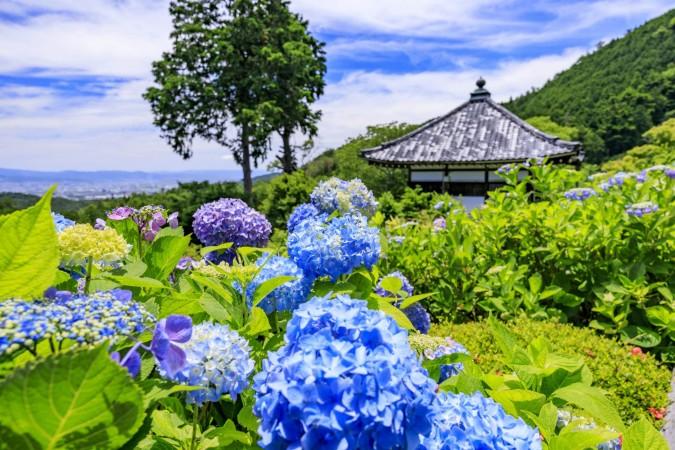
Hasedera Hydrangea garden - © Japan Web Magazine
What to Do in Kamakura
- Hiking in Kamakura: Kamakura is surrounded by lush hills, offering excellent hiking opportunities. The Daibutsu Hiking Trail and Tenen Hiking Course are popular routes that take you through scenic landscapes and past historical sites, providing both exercise and exploration.
- Coastal Retreat at Yuigahama Beach: Yuigahama Beach is a favorite spot for both locals and tourists. Whether you're interested in swimming, sunbathing, or enjoying water sports, the beach offers a relaxing getaway with beautiful views of the coastline.
- Experience Japanese Tea Ceremonies: Take part in a tea ceremony to gain an understanding of traditional Japanese culture. Local tea houses offer sessions where you can learn the art of tea preparation, providing a hands-on cultural experience.
- Hands-on Traditional Workshops: Engage in traditional workshops such as calligraphy, pottery, and fabric dyeing. These activities offer a deeper understanding of Japanese arts and crafts, allowing you to create your own unique souvenirs.
- Visit Enoshima Island: Just a short trip from Kamakura, Enoshima Island offers a mix of natural beauty and cultural sites. Visit the Enoshima Shrine, explore the island's caverns, and take in the expansive vistas from the lighthouse.
- Temples and Shrines Tours: Kamakura is home to numerous historical temples and shrines. Take a tour of significant sites such as the Great Buddha of Kamakura, Hasedera Temple, and Tsurugaoka Hachimangu Shrine to immerse yourself in the city's rich heritage.
- Zen Gardens Wellness Retreat: Visit the serene Zen gardens at temples like Engaku-ji and Kencho-ji. These beautifully landscaped gardens offer a peaceful retreat and a glimpse into the Zen Buddhist tradition.
- Kamakura Food Tours: Savor the flavors of Kamakura by trying local dishes such as shirasu, Kamakura vegetables, and traditional sweets. Many restaurants and cafes offer seasonal specialties that highlight the region's culinary delights.
Shopping in Kamakura
- Komachi Street Shopping: Komachi Street is a bustling shopping area filled with unique boutiques, souvenir shops, and local eateries. It's the perfect place to find handmade crafts, traditional goods, and one-of-a-kind gifts to take home.
- Zeniarai Benzaiten Shopping Street: Near the Zeniarai Benzaiten Shrine, this shopping street features stores selling a mix of traditional and modern goods. Find unique items such as locally crafted jewelry, handmade textiles, and spiritual souvenirs.
- Hase Street: Close to Hasedera Temple and the Great Buddha, Hase Street is lined with shops offering a variety of goods. From traditional sweets and snacks to beautiful ceramics and clothing, this street is ideal for finding memorable gifts and keepsakes.
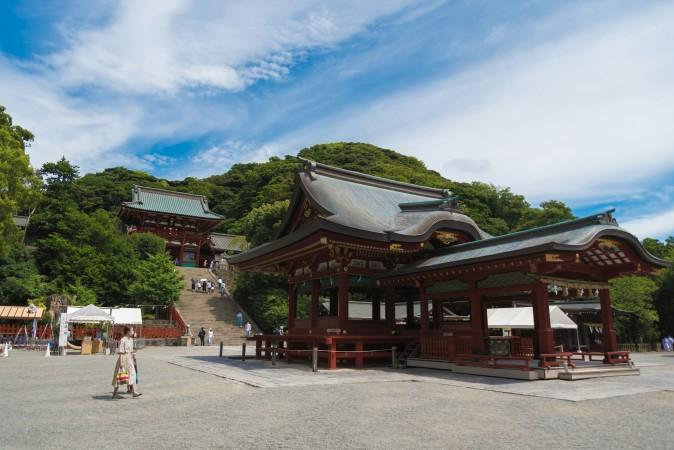
Temples and Shrines Exploration - © Tsukada Kazuhiro
Weather in Kamakura: Best Time to Visit
Spring in Kamakura
- Weather: Spring in Kamakura is mild and pleasant, with temperatures ranging from 10°C to 20°C (50°F to 68°F). Cherry blossoms bloom during this season, creating picturesque scenery.
- Tourism Trend: Spring is one of the most popular times to visit Kamakura due to the cherry blossoms. The blooming season attracts large crowds to iconic spots like Tsurugaoka Hachimangu Shrine and Hase-dera Temple. It’s a great time for photography, sightseeing, and participating in traditional seasonal events.
Summer in Kamakura
- Weather: Summer in Kamakura can be hot and humid, with temperatures averaging between 20°C and 30°C (68°F to 86°F). Rain showers are common, especially in June.
- Tourism Trend: Summer draws visitors to Yuigahama Beach for sunbathing and water sports. Beachgoers flock to the coast to escape the heat. Summer festivals and fireworks displays, such as the Kamakura Fireworks Festival, are popular attractions.
Autumn in Kamakura
- Weather: Autumn is marked by comfortable temperatures ranging from 15°C to 25°C (59°F to 77°F). The foliage changes to vibrant hues of red, orange, and yellow.
- Tourism Trend: Autumn is a favored season for travelers due to the beautiful fall colors. Hiking trails, such as the Daibutsu Hiking Trail, offer stunning views of the foliage. The crisp weather is perfect for exploring Kamakura’s temples and shrines, and the changing leaves make for excellent photography opportunities.
Winter in Kamakura
- Weather: Winter in Kamakura is relatively mild, with temperatures between 5°C and 15°C (41°F to 59°F). The weather is clear, offering great views of Mount Fuji.
- Tourism Trend: Winter is a quieter season for tourism, but it offers a serene and peaceful atmosphere. Visitors enjoy clear skies and crisp air, making it ideal for sightseeing and outdoor activities. New Year's celebrations at Tsurugaoka Hachimangu Shrine are a highlight, as people participate in Hatsumode (first shrine visit of the year).
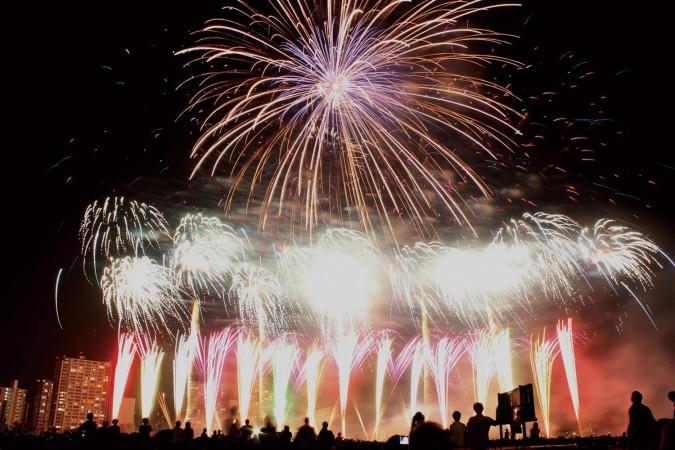
Kamakura Fireworks Festival in Summer - © VnExpress
Culture Etiquette in Kamakura
Public Behavior
- Quiet and Considerate: Keep your voice low and avoid making phone calls on public transportation. Many people use their commute as a time for relaxation or reading.
- Cleanliness: Littering is strongly discouraged. Carry your trash with you until you find a designated disposal area. Kamakura prides itself on cleanliness and orderliness.
- Respect for Space: Be mindful of others’ personal space. On public transport, give up your seat to the elderly or those in need, and be courteous to fellow passengers.
- Bowing as a Greeting: A slight bow is typically used for casual greetings, while a deeper bow signifies respect and gratitude. This tradition reflects the polite and humble nature of Japanese culture.
Temple and Shrine Etiquette
- Purification Rituals: Before entering a temple or shrine, wash your hands and mouth at the chozuya (water basin) to purify yourself. Use the ladle to pour water over your hands and rinse your mouth discreetly.
- Approach the Main Shrine: When approaching the main shrine building, bow twice, clap twice, and then bow once more before offering your prayer or making a donation.
- Respectful Silence: Maintain a respectful silence inside temple and shrine premises. Avoid loud conversations and keep your phone on silent mode to preserve the tranquil atmosphere.
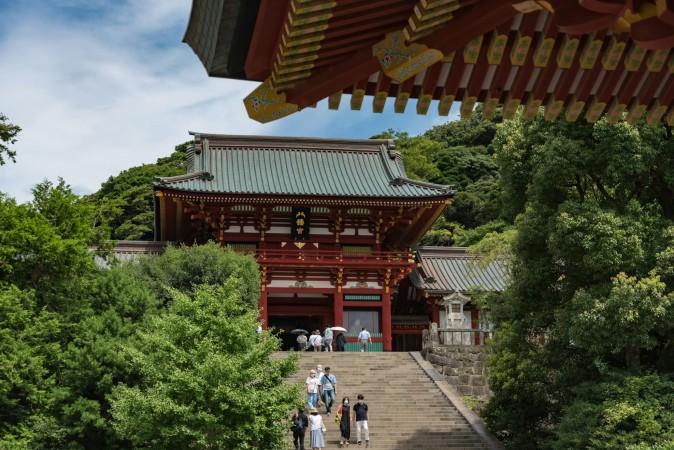
Follow the temple and shrine customs when travel to Kamakura - © Tsukada Kazuhiro
Essential Travel Information
Getting Around Kamakura
- Trains: Kamakura is well-connected by train, making it easy to reach from Tokyo and other nearby cities. The JR Yokosuka Line and the Enoshima Electric Railway (Enoden) are the primary train services, offering picturesque views of the coastline and access to key attractions.
- Buses: Local buses are a convenient way to get around Kamakura, especially for reaching areas not served by trains. The buses are frequent and cover major tourist sites, including temples, shrines, and the beach.
- Bicycles: Renting a bicycle is a popular option for exploring Kamakura. Cycling allows you to cover more ground and enjoy the scenic beauty at your own pace.
- Walking: Kamakura is a compact city with many attractions within walking distance. Walking is one of the best ways to explore the historic streets, discover hidden gems, and experience the local atmosphere.
ATM & Banking Services
ATMs are readily accessible in Kamakura, particularly in tourist areas and near transportation hubs. For banking services, there are several options for currency exchange and cash withdrawal throughout the city. Although credit cards are widely accepted at most hotels, restaurants, and larger shops, it’s wise to carry some cash, as smaller businesses and traditional establishments often prefer cash transactions.
Where to Stay in Kamakura
- Ryokan (Traditional Inns): Experience authentic Japanese hospitality with traditional inns offering tatami-mat rooms, futon bedding, and meals featuring local cuisine. These accommodations blend comfort with cultural immersion.
- Hotels: Choose from a range of hotels to suit various budgets and preferences. Options include luxury hotels with ocean views and more affordable choices that provide modern amenities and convenient access to major attractions.
- Temple Lodgings (Shukubo): Enjoy a unique stay at a temple lodging, where you can participate in temple activities such as morning prayers and meditation. This provides a calm and spiritually enlightening experience that is closely linked to the cultural history of the city.
Articles for you

Experience Aboard The RV Indochine II - A Mekong Cruise With Tweet World Travel
The RV Indochine II is a luxury river cruise ship, offering an unforgettable journey through many attractions along the Mekong River. Built in 2017, this upscale vessel combines colonial elegance with modern conveniences to create a comfortable yet stylish environment for its crew and passengers. The ship’s intimate size makes it ideal for those seeking a more personal cruising experience while exploring Vietnam and Cambodia rich culture, scenery, and heritage. Whether you're gazing at the landscape from your private balcony or enjoying authentic local cuisine, RV Indochine II promises an exotic adventure like no other.

Witness Stilt Fishing In Sri Lanka: An Eco-Tourism Experience
Sri Lanka, renowned for its stunning beaches and rich cultural heritage, harbors a unique tradition that has captivated travelers for centuries: stilt fishing. This ancient practice, passed down through generations of coastal communities, blends artistry with necessity, offering a glimpse into a way of life intimately connected to the island's coastal rhythms. Stilt fishing in Sri Lanka isn't merely a means to catch fish; it's a cultural emblem, embodying the resilience and ingenuity of Sri Lanka's fishing communities.

Make Your Trip Stress-Free With The Tweet Trip App
Embark on your next adventure with confidence by downloading the Tweet Trip App, available for both iOS and Android. This essential travel companion allows you to view your detailed itinerary, stay connected with your tour guide and fellow travelers, receive real-time updates, and provide feedback effortlessly. With features like in-app messaging, emergency assistance, and location sharing, the Tweet Trip App ensures you travel smarter, stay connected, and enjoy a seamless, worry-free journey. Get started today and make the most of your travel experience with Tweet World Travel.

Pedal Through Paradise: Unveiling Cambodia's Hidden Gems on Two Wheels
The gentle whir of bicycle wheels mingles with the distant chants of monks as you glide past emerald rice paddies stretching to the horizon. This is Cambodia - a sensory explosion waiting to be experienced on two wheels. At Tweet Tours, we believe there's no better way to immerse yourself in the Kingdom of Wonder than by bicycle.
Cambodia isn't just a destination; it's a living, breathing tapestry of ancient wonders, natural beauty, and vibrant culture. Our carefully crafted cycling tours take you beyond the typical tourist haunts, offering a unique perspective on this captivating country. Ready to clip in and discover the magic of Cambodia? Let's ride!

Trekking in the Himalayas: A Journey Through Nepal's Majestic Peaks
The Himalayas rise from the earth like colossal guardians, their snow-capped peaks piercing the sky in a display of nature's raw power and beauty. Nepal, nestled at the heart of this mountain range, serves as the gateway to some of the most breathtaking trekking experiences on the planet. Here, the air is crisp and thin, filled with the promise of adventure and the whispers of ancient tales.
With Tweet Tours, as you set foot on these hallowed trails, you're not just a traveler - you're a modern-day explorer, following in the footsteps of legendary mountaineers and age-old traders. Each step takes you further into a world where nature reigns supreme and human resilience is tested against the backdrop of some of the world's highest peaks.
From the moment your boots touch the ground in Kathmandu, you'll feel the pull of the mountains. The bustling streets of the capital, with their sensory overload of sights, sounds, and smells, soon give way to serene mountain paths where the only soundtrack is the crunch of gravel underfoot and the distant tinkling of yak bells.

Exploring Mui Ne's Wonders: Unique Attractions & Local Dishes
Nestled along the southeastern coast of Vietnam, Mui Ne emerges as a captivating gem, blending natural wonders with cultural richness. Renowned for its stunning landscapes and unique attractions, Mui Ne beckons travelers seeking both relaxation and adventure in equal measure. Mui Ne's renowned beach dunes, bustling fishing towns, and excellent local food await exploration at every turn.
The allure of Mui Ne lies not only in its pristine beaches and crystal-clear waters but also in its diverse range of activities catering to every traveler's whims. Whether you're drawn to thrilling water sports like kitesurfing and windsurfing on its dynamic shores or seeking tranquility amidst the picturesque Fairy Stream, Mui Ne promises an unforgettable journey filled with discovery.
